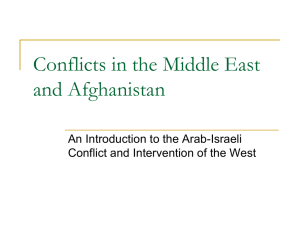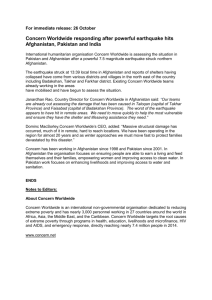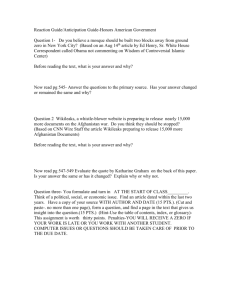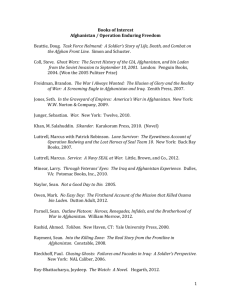Afghanistan Timeline of Instability
advertisement
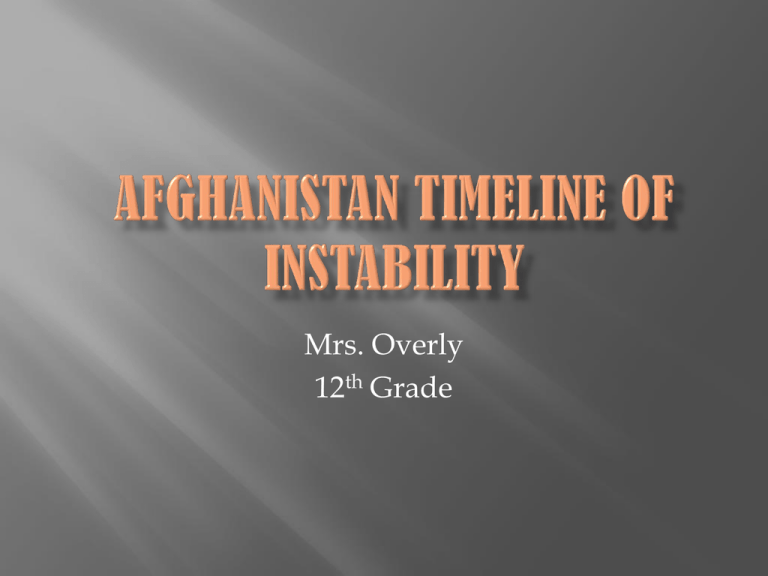
Mrs. Overly 12th Grade Afghanistan takes great pride in the fact that no outside forces have ever been successful in controlling their country. Alexander the Great Ghengis Khan Yet, at the same time, when they are not chasing out Britain, Russia, and NATO forces (including United States) their past is scarred with civil war and racist religious persecution. The people of Afghanistan largely accept that religion should shape government, but since many interpret the Koran and Shari'a Law differently, conflict continues. Because of Afghanistan’s key location as a middle east passage route between India and the Persian capitals, the land was always involved with a territory war. Many different ‘empires’ were raised and torn down during 300-1000 AD Many different cultural groups landed and stayed in the area. At one time the area was largely Buddhist and not Muslim. Afghanistan borders are defined and the country is led by Ahmad Shah Durrani As Britain expanded her colonization world wide, they tried to stretch into Afghanistan in 1800. This effort did not pan out for Britain despite the fact that they tried for nearly 100 years to win wars in Afghanistan in order to control the leadership. The Anglo-Afghan war placed British troops in a terrain that was unfamiliar and brutal. After three tries, Britain pulled out forces in 1919 Within Afghanistan, the separation between the two cultural groups is marked by periods of great tension. Various cultural groups want more control and voice in the government. 1919-1929: King Amanullah, a Pashtun, takes the throne and worked to end Afghanistan's isolation. People did not want change and the king is overthrown by Pashtun and Tajik tribes. 1933: Mohammad Zahir Shah becomes the king of Afghanistan. Shah was a Pashtun but felt strongly about unifying Afghanistan. He worked hard to unite the divided country and offer opportunities to all groups and women. His life story is important in The Kite Runner because he is chased out of power and was exiled from his country. Recently died (2007) 1964: King Zahir Shah starts experimenting with democracy and the legislature is partly elected. At the same time, the communist People Democratic Party of Afghanistan (PDPA) emerges; this group has close ties to the Soviet Union. Meanwhile, there is a division in the country where half of the Pashtun party want to work with USSR and others do not. 1973: Zahir Shah is overthrown by his cousin Sardar Mohammad Daoud, a Pashtun. Daoud abolishes the monarchy and proclaims Afghanistan as a republic with himself as president. His efforts to bring about social and economic reforms were unsuccessful. Shah was actually out of the country getting surgery in Italy when we heard about the takeover of his palace. He never returned. Shah’s younger cousin takes over as head of Afghanistan with the help of the Soviet Union Of course, the power went straight to his head and he wildly misread how much control he had over the country with the USSR now in charge. It became quickly obvious that USSR no longer needed Doaud and his constant interference with their economic goals grew annoying. 1978: The communist coup, a.k.a. the April Revolution, takes place. The coup takes place because Daoud wanted to reduce Soviet influence. As a result, the PDPA murdered Daoud and his family. Taraki, a PDPA leader, takes power and employs a Marxist government. Throughout the next ten years, the USSR appointed Afghan puppet leaders but whenever any of them started to head in a direction USSR didn’t like, they were assasinated. Soviet occupation in Afghanistan upset all of Afghani people. Reports of abuse, rape, extortion, and murders by Soviet soldiers were common news. Communist forces expelled religion practice. Nobody could protect the Afghani people or their faith…well, maybe somebody…


